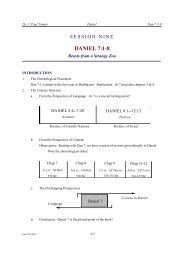Sess13-Jerem Back-Syn1.pdf - J. Paul Tanner
Sess13-Jerem Back-Syn1.pdf - J. Paul Tanner
Sess13-Jerem Back-Syn1.pdf - J. Paul Tanner
You also want an ePaper? Increase the reach of your titles
YUMPU automatically turns print PDFs into web optimized ePapers that Google loves.
Dr. J. <strong>Paul</strong> <strong>Tanner</strong> Old Testament III <strong>Jerem</strong>iah: <strong>Back</strong>ground & Synthesis I<br />
4. 8:8 – superficial righteousness! The LORD desired true righteousness of heart (9:23-24).<br />
5. The heart of this address: unless Judah repented, Jerusalem would be as Shiloh (7:12; cf.<br />
26:4-6).<br />
D. Call for Covenant Faithfulness (Ch 11–12)<br />
1. No date is given for this unit, and the historical setting is debated.<br />
2. Feinberg comments, "Some, recognizing that <strong>Jerem</strong>iah is condemning Judah for<br />
disobeying the law of Moses, hold that the time must be in Jehoiakim's reign, when there<br />
was a retrogression from the reformation in Josiah's reign. Others hold, and their view<br />
represents a consensus of expositors, that the historical setting was the reign of Josiah<br />
with his reformation, which proved to be only superficial. This position is preferable.<br />
The date might even have been soon after the discovery of the Book of the Law before<br />
the reform became widespread (v. 6; cf. 2 Kings 23)." 3<br />
3. Several verses hint that this probably followed the discovery of the Book of the Law<br />
(11:2,6). 11:6 could be looking at Josiah's proclamation of the Law and his call for<br />
reforms.<br />
E. Signs to Awaken Repentance (Ch 13–19)<br />
These chapters utilize several vivid object lessons designed to awaken Judah to repentance.<br />
This includes the linen waistband (13:1), a drought (14:1), <strong>Jerem</strong>iah's celibacy (16:2), the<br />
potter's wheel and clay (18:1), and the broken jar (19:1). Chisholm explains the significance of<br />
these in light of the historical context:<br />
To illustrate the coming judgment, the Lord gave the people vivid object lessons. He<br />
instructed <strong>Jerem</strong>iah to refrain from taking a wife, mourning over the dead, or<br />
participating in feasts (16:1-9). <strong>Jerem</strong>iah's celibate lifestyle foreshadowed the decimation<br />
of the nation's families. The sword and famine would rob families of husbands/fathers,<br />
wives/mothers, and children. The prophet's refusal to participate in funerals anticipated<br />
the day when people would not have time or opportunity to bury their dead, let alone<br />
formally lament over them. Feasting was inappropriate, for God's judgment would soon<br />
bring an end to all the land's joyous celebrations. 4<br />
1. Judah's need was to cling to the LORD (13:11). This is the same Hebrew word used in<br />
Gen 2 for the man and woman clinging to each other.<br />
2. Notice the prevalence of those in the nation who are deceived into thinking that they are<br />
prophesying for the LORD (14:13-14).<br />
3. 15:4 – The evil of Manasseh is a primary factor that sealed the fate of the Southern<br />
Kingdom of Judah.<br />
4. 17:5-10 – Observe God's evaluation of humanism.<br />
5. 20:7-11 – Observe <strong>Jerem</strong>iah's personal struggle in the ministry.<br />
F. <strong>Jerem</strong>iah Confronted Followed by Emotional Turmoil (Ch 20).<br />
3 Charles L. Feinberg, <strong>Jerem</strong>iah, The Expositor's Bible Commentary, Vol. 6 (Grand Rapids, MI:<br />
Zondervan Pub. House, 1986), 95-96.<br />
4 Chisholm, 351.<br />
Jan 10, 2001 13.4




